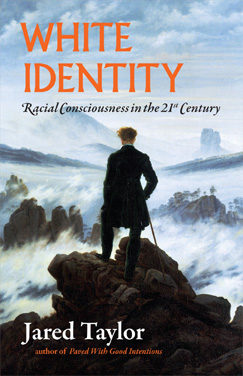In 2012, Jared Taylor wrote, “Like communism, liberalism will be battered to death by the facts before it concedes that its morality was mistaken.” Mr. Taylor’s best known book, White Identity: Racial Consciousness in the 21st Century, published ten years ago, is a 300-page battering ram of facts.
The first four chapters, in particular, are a relentless demonstration that “multiculturalism” is a burden and a failure. There are hundreds of examples, making his book almost encyclopedic. Here are some memorable ones. On page 86:
The more intimate the setting, the greater the challenges of diversity. Adopted children, for example, often report they never felt they fit in. In a British study of adults who were adopted as children, 46 percent of whites adopted by whites said they felt a sense of not belonging. For non-whites adopted by whites, the figure rose to close to 75 percent. Researchers reported that their constant refrain was, ‘Love is not enough.’
There can be worse: the authors of a 2005 study on domestic violence in the United States reached the sobering conclusion that ‘the incidence of spousal homicide is 7.7 times higher in interracial marriages compared to intraracial marriages.’
One study for the period of 1979 to 1981 found that white men who married black women were 21.4 times more likely to be killed by their spouses than white men who married white women. A white woman increased her risk of being killed 12.4 times by marrying a black man. Marrying a white did not appreciably change a black person’s risk of being killed by his or her spouse.
On page 100:
The effort whites put into observing racial etiquette has been demonstrated in the laboratory. In experiments at Tufts University and Harvard Business School, a white subject was paired with a partner, and each was given 30 photographs of faces that varied by race, sex, and background color. They were then supposed to identify one of the 30 faces by asking as few yes-or-no questions as possible. Asking about race was clearly a good way to narrow down the possibilities — whites did not hesitate to use that strategy when their partner was white — but only 10 percent could bring themselves to mention race if their partner was black. They were afraid to admit that they even noticed race.
When the same experiment was done with children, even white 10- and 11-year olds avoided mentioning race, though younger children were less inhibited. Because they were afraid to identify people by race if the partner was black, older children performed worse on the test than younger children. ‘This result is fascinating because it shows that children as young as 10 feel the need to try to avoid appearing prejudiced, even if doing so leads them to perform poorly on a basic cognitive test,’ said Kristin Pauker, a PhD candidate at Tufts who co-authored the study.
On pages 108-109:
What, then, are the advantages of diversity that not only compensate for agonizing conflicts but justify considering it America’s ‘greatest strength?’ If readers cannot immediately think of any besides ethnic restaurants, they are not alone. A 2007 study by the University of Minnesota found that Americans claim to be positive and even optimistic about the word ‘diversity’ but are unable to explain its value or give examples of its benefits. The researchers found that even people who work in the field of race relations stumble when asked to list its benefits.
In 2009, a San Francisco radio personality named Marty Nemko agreed to host an on-air debate on workplace diversity in which the author of this book was to argue that it was a weakness, not a strength. Mr. Nemko contacted a Georgia-based diversity consultant whose slogan was ‘Stronger Performance Through Diversity,’ fully expecting that he would be happy to argue the other side. The consultant declined, admitting that he did not think diversity was a strength, only that it can be made to work better with ‘diversity management’ of the kind he offers.
No other book so comprehensively lays out the evidence for why race realists are right and egalitarians are wrong. The facts Mr. Taylor marshals are important, and deserve to be better known. With its neutral, journalistic tone and its hundreds of endnotes, White Identity is an invaluable attempt to deliver the facts to the unconvinced.
That is the book’s greatest strength — and its greatest weakness. There’s a rumor that a very prominent conservative commentator began reading White Identity but put it down because he found it too depressing. I’ve always believed that story because the book is depressing. I’m confident that’s why many conservatives are hesitant to learn more about race. Liberals, meanwhile, are content to call dissenting views “racist” and ignore the facts.
White Identity contains a vast store of rhetorical ammunition for any argument about why we are right and everyone else is wrong. With those facts so carefully marshaled, it is time to start talking about faith, purpose, good news, and the spiritual sickness of “anti-racist” whites.
Editor’s Note: You can buy a copy of White Identity here.
